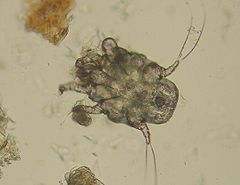- Ear mite
-
Ear mite Otodectes cynotis Scientific classification Kingdom: Animalia Phylum: Arthropoda Subphylum: Chelicerata Class: Arachnida Subclass: Acarina Superorder: Acariformes Order: Astigmata (unranked): Psoroptidia Superfamily: Psoroptidae (partim)[verification needed] Genera Several, including:
Otodectes
PsoroptesEar mites are mites that live in the ears of animals. The most commonly seen species is Otodectes cynotis (Gk. oto=ear, dectes=biter, cynotis=of the dog).
Contents
Contagion
Ear mites spread rapidly, and can be transmitted from even brief physical contact with other animals. In pets, ear mites most commonly affect cats, ferrets, and to a lesser extent dogs. Humans can be infected with ear mites.[1][2][3] Infected animals have a large amount of crumbly dark brown material in their ears. On close inspection, tiny white mites can be seen in the debris. Ear mites do not burrow as some mites do, but live within the ear canal.[citation needed]
Life Cycle
The life cycle of an individual mite is about 4 weeks, with eggs hatching on the 3rd or 4th day after laying. Female mites are able to reproduce after about 3 weeks.[4]
Consequences of infection
The ear mite is the most common cause of ear infections in cats, quickly spreading from one cat to another through direct contact.[5] Ear mites cause inflammatory symptoms, similar to bacterial and yeast infections. Symptoms include itching and redness of the ears. Other, more serious problems can result from untreated infections, such as skin disease in areas other than the ear like the neck and tail, and deafness.[6]
Treatment
Ear mite infection can be treated topically after removal of debris from the ear. Various antiparasitic medications are available for use in the ears. Households with multiple infected pets can be treated with oral or injectable ivermectin.[6] There is also a product labelled for treatment of ear mites in cats known as selamectin that is used on the skin and lasts for one month.[citation needed]
Ear mites in rabbits
The rabbit ear mite, Psoroptes cuniculi, is larger than Otodectes cynotis. It causes thick firm debris to form in the ear canal, and can eventually migrate to the skin of the outer ear and face. Symptoms include scratching and shaking of the head. Treatment includes injections of ivermectin and frequent cleanings of the rabbit's environment.[7]
References
- ^ Al-Arfaj, AM; Mullen, GR; Rashad, R; Abdel-Hameed, A; Oconnor, BM; Alkhalife, IS; Dute, RR (2007). "A human case of otoacariasis involving a histiostomatid mite (Acari: Histiostomatidae)". The American journal of tropical medicine and hygiene 76 (5): 967–71. PMID 17488924. http://www.ajtmh.org/cgi/pmidlookup?view=long&pmid=17488924.
- ^ Klemm, E; Haroske, G; Wollina, U (2009). "Otitis externa and myringitis due to demodicidosis". Acta dermatovenerologica Alpina, Panonica, et Adriatica 18 (2): 73–6. PMID 19588062. http://www.zsd.si/ACTA/PUBLIC_HTML/acta-apa-09-2/6.pdf.
- ^ http://www.youtube.com/watch?v=Z7CLzqMCmqE[unreliable medical source?]
- ^ "Ear Mite: Otodectes cynotis". http://ipm.ncsu.edu/ag369/notes/ear_mite.html.[unreliable medical source?]
- ^ "Ear Mites and Health Care for Cats and Dogs". PetsMD. http://www.petsmd.com/cats-and-dogs/Ear-Mites.html.
- ^ a b Griffin, Craig E.; Miller, William H.; Scott, Danny W. (2001). Small Animal Dermatology (6th ed.). W.B. Saunders Company. ISBN 0-7216-7618-9.[page needed]
- ^ Hillyer, Elizabeth V.; Quesenberry, Katherin E. (1997). Ferrets, Rabbits, and Rodents: Clinical Medicine and Surgery (1st ed.). W.B. Saunders Company. ISBN 0-7216-4023-0.[page needed]
External links
Categories:- Parasitic animals
- Veterinary entomology
Wikimedia Foundation. 2010.


